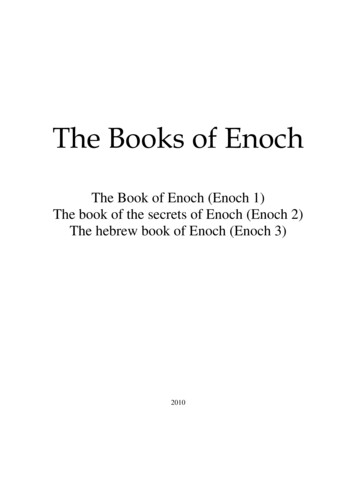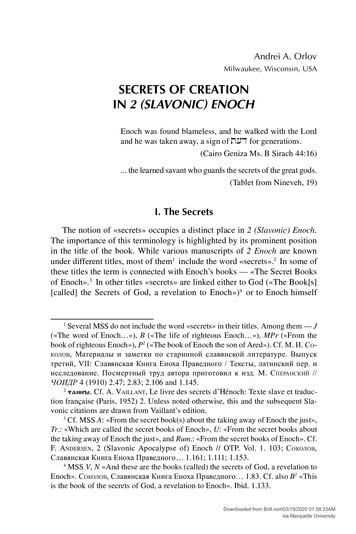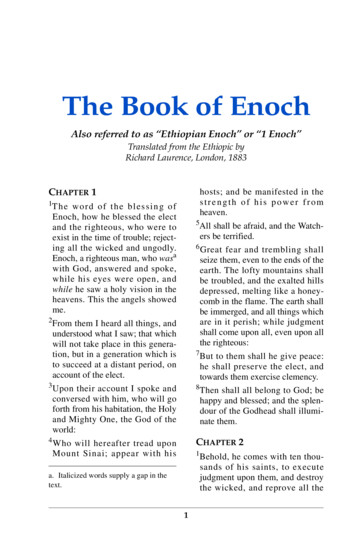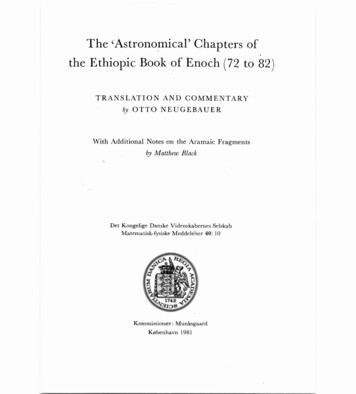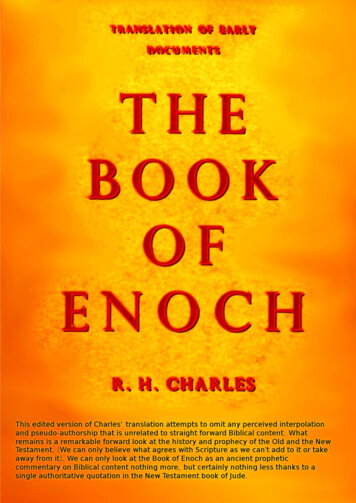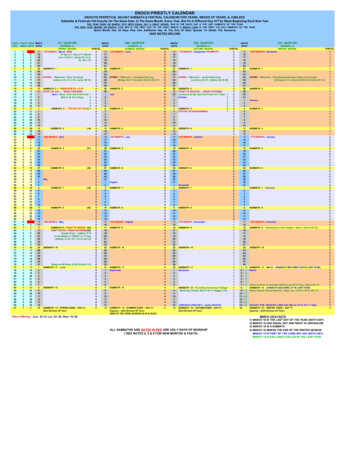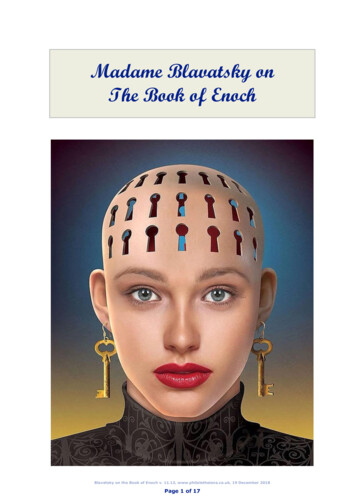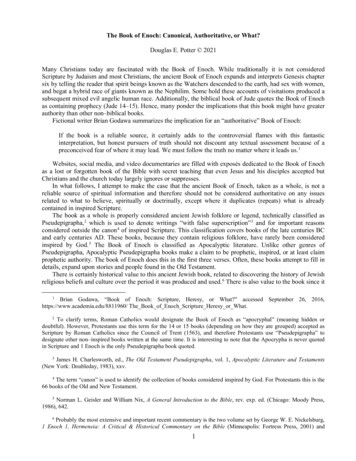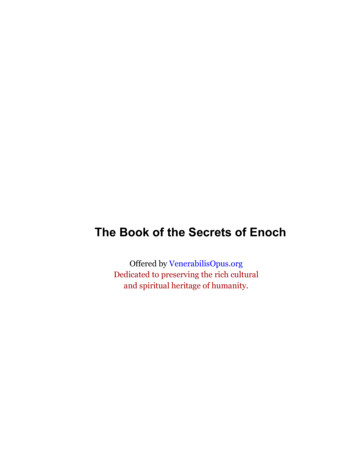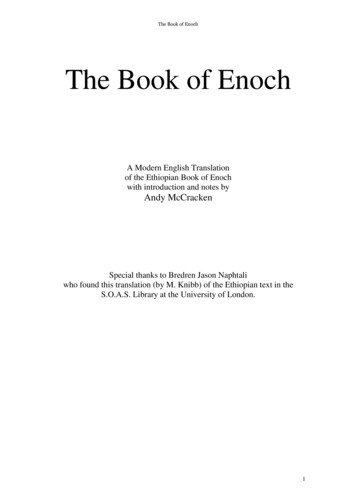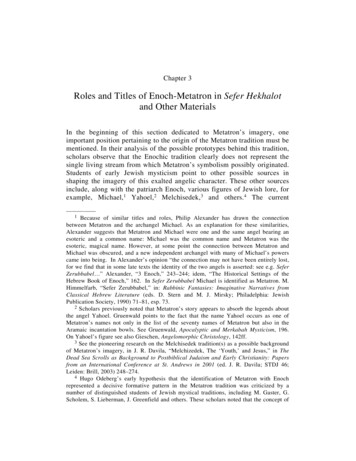
Transcription
Chapter 3Roles and Titles of Enoch-Metatron in Sefer Hekhalotand Other MaterialsIn the beginning of this section dedicated to Metatron’s imagery, oneimportant position pertaining to the origin of the Metatron tradition must bementioned. In their analysis of the possible prototypes behind this tradition,scholars observe that the Enochic tradition clearly does not represent thesingle living stream from which Metatron’s symbolism possibly originated.Students of early Jewish mysticism point to other possible sources inshaping the imagery of this exalted angelic character. These other sourcesinclude, along with the patriarch Enoch, various figures of Jewish lore, forexample, Michael,1 Yahoel,2 Melchisedek,3 and others.4 The current—————1 Because of similar titles and roles, Philip Alexander has drawn the connectionbetween Metatron and the archangel Michael. As an explanation for these similarities,Alexander suggests that Metatron and Michael were one and the same angel bearing anesoteric and a common name: Michael was the common name and Metatron was theesoteric, magical name. However, at some point the connection between Metatron andMichael was obscured, and a new independent archangel with many of Michael’s powerscame into being. In Alexander’s opinion “the connection may not have been entirely lost,for we find that in some late texts the identity of the two angels is asserted: see e.g. SeferZerubbabel ” Alexander, “3 Enoch,” 243–244; idem, “The Historical Settings of theHebrew Book of Enoch,” 162. In Sefer Zerubbabel Michael is identified as Metatron. M.Himmelfarb, “Sefer Zerubbabel,” in: Rabbinic Fantasies: Imaginative Narratives fromClassical Hebrew Literature (eds. D. Stern and M. J. Mirsky; Philadelphia: JewishPublication Society, 1990) 71–81, esp. 73.2 Scholars previously noted that Metatron’s story appears to absorb the legends aboutthe angel Yahoel. Gruenwald points to the fact that the name Yahoel occurs as one ofMetatron’s names not only in the list of the seventy names of Metatron but also in theAramaic incantation bowls. See Gruenwald, Apocalyptic and Merkabah Mysticism, 196.On Yahoel’s figure see also Gieschen, Angelomorphic Christology, 142ff.3 See the pioneering research on the Melchisedek tradition(s) as a possible backgroundof Metatron’s imagery, in J. R. Davila, “Melchizedek, The ‘Youth,’ and Jesus,” in TheDead Sea Scrolls as Background to Postbiblical Judaism and Early Christianity: Papersfrom an International Conference at St. Andrews in 2001 (ed. J. R. Davila; STDJ 46;Leiden: Brill, 2003) 248–274.4 Hugo Odeberg’s early hypothesis that the identification of Metatron with Enochrepresented a decisive formative pattern in the Metatron tradition was criticized by anumber of distinguished students of Jewish mystical traditions, including M. Gaster, G.Scholem, S. Lieberman, J. Greenfield and others. These scholars noted that the concept of
Sefer Hekhalot87investigation supports this view and will demonstrate that even in theEnochic tradition Metatron’s imagery was gradually developed as a result ofits interaction with various external characters prominent in thepseudepigraphic mediatorial traditions. The fact that the Enochic tradition isnot solely responsible for the shaping of the image of Metatron can be seenin rabbinic and Hekhalot materials, the majority of which do not directlyidentify this angel with the seventh antediluvian patriarch. This situationsets parameters and priorities for this present chapter on the Metatron lore,which will rely first on the materials that unambiguously identify thisprincipal angel with Enoch and, then, on other rabbinic and Hekhalotevidence where this explicit identification was not made.This analysis will mainly focus on 3 Enoch, a Merkabah text also knownas Sefer Hekhalot (the Book of [the Heavenly] Palaces), where theconnection between Enoch and Metatron is made explicit.5 3 Enochoccupies a special place in the corpus of the Hekhalot writings in light of itsunique form, content, and the identity of the main character.6 It should benoted that the role of Sefer Hekhalot in the history of Jewish mysticism, as—————Metatron cannot be explained solely by the reference to the early Enochic lore becauseMetatron has taken many of the titles and the functions that are reminiscent of those thatthe archangel Michael, Yahoel and other elevated personalities possess in early Jewishtraditions. Despite the critique of Odeberg’s position, the possible influence of the Enochictradition on the Metatron imagery has never been abandoned by the new approaches,mainly in the view of the evidence preserved in Sefer Hekhalot. For example, Scholemrepeatedly referred to several streams of the Metatron tradition, one of which, in hisopinion, was clearly connected with early Enochic developments. Scholars however oftenconstrue this “Enochic” stream as a later development that “joined” the Metatron traditionafter its initial formative stage.5 The question of the literary integrity of Sefer Hekhalot is a complicated issue. PhilipAlexander argues for the existence of the “core” of the text which in his opinion includeschapters 3–15/16 and the latter additions to this “core.” He observes that “an inspection ofthe textual tradition shows that chapters 3–15/16, which describe the elevation of Enoch,circulated as an independent tract and it is intrinsically probable that these chaptersformed the core round which the longer recensions grew.” Alexander, “The HistoricalSettings of the Hebrew Book of Enoch,” 156–7. Peter Schäfer criticizes Alexander’sanalysis of the composition of 3 Enoch and his hypothesis of the “core” of the text.Schäfer argues that textual evidence shows that this part of 3 Enoch was divorced from itscontext only in the course of the medieval transmission of the text. (See P. Schäfer, et al.,Übersetzung der Hekhalot–Literatur, 1.LI). Rejecting Alexander’s literary-scientificmodel of the theory of layers as dubious, Schäfer demonstrates that the currently availablemanuscript tradition, the beginning of the macroform of 3 Enoch with §1 and the end farbeyond §§19/20, witnessed by the older manuscripts (Geniza-Fragment, Florenz,Casanatense, Zürich, Vatican, München 40) is so constant that it appears difficult torecognize a “more original” stage of the text in §§ 4–19/20. P. Schäfer, “Handschriften zurHekhalot-Literatur,” in: Schäfer, Hekhalot Studien, 228.6 The detailed discussion of the literary character of 3 Enoch and its possibletransmission history extends beyond the boundaries of the current investigation.
88Evolution of the Roles and Titleswell as its position in relation to the rest of the corpus of Hekhalot writings,still awaits a complete assessment. Scholars have routinely noted that thevarious traditions found in 3 Enoch represent a later stage of developmentthan those attested in other Hekhalot writings.7 Yet the unique structure ofthis work,8 the lack of Merkabah hymns9 and adjuration patterns10prominent in other Hekhalot works, its peculiar angelology,11 and mostimportantly the persistent identification of Metatron with the patriarchEnoch might indicate that this work belongs to the peculiar mold ofMerkabah mysticism which stemmed from the early Enochic lore.Unfortunately, the aforementioned features of Sefer Hekhalot have not yetreceived comprehensive treatment from students of early Jewish mysticism,although several useful studies have already been undertaken.12 It is hopedthat this investigation of 2 Enoch, its connection with the Merkabahtradition in general and with Sefer Hekhalot in particular, will provide somefurther contribution in this area.Now this study should return to its main subject, namely, the question ofthe roles and titles of Enoch-Metatron. The prima facie assessment of thetext indicates that Sefer Hekhalot contains two clusters of roles and titles of—————7 See, for example, Swartz, Scholastic Magic, 178ff.8 Joseph Dan has argued that Sefer Hekhalot “is the only one among the treatises ofthe Hekhalot literature whose beginning is like that of the Midrash, i.e., with a verse beingquoted and the work going on to interpret the verse. Generally we do not find manyexpository principles in this literature.” Dan, The Ancient Jewish Mysticism, 110.9 Philip Alexander has recognized the absence of Merkabah hymns in 3 Enoch, whichare a common feature in Merkabah texts such as Hekalot Rabbati and Ma(aseh Merkabahand has shown that the only heavenly hymns in 3 Enoch are traditional and biblical.Alexander, “3 Enoch,” 245.10 Peter Schäfer observes that “the formal language of the adjuration formulas is veryspecific and manifold and witnessed in almost all [Hekhalot] macroforms (seldom inHekhalot Zutarti and not at all in 3 Enoch).” Schäfer, The Hidden and Manifest God, 144.11 Scholars stress the distinctive angelology of Sefer Hekhalot. Peter Schäfer notes theemphasis on angelology as a peculiar feature of the work. He observes that “in no other[Hekhalot] microform are the angels the central theme as in 3 Enoch. Only here is asystematized angelology (whereby an attempt is made to combine various systems) and acomprehensive hierarchy to be found.” Schäfer, The Hidden and Manifest God, 144.Ithamar Gruenwald’s research emphasizes the uniqueness of the angelological imagery of3 Enoch where most of the angels perform cosmological duties, and their names derivefrom the Hebrew names of the objects and phenomena in Nature over the function ofwhich they are appointed. In Gruenwald’s opinion, this cosmological orientation of 3Enoch’s angelology points to a connection with the early Enochic lore, since “this type ofangelology is known from the apocalyptic Enoch literature and it should be distinguishedfrom yet another type of angelology – magical angelology – which can be found in SeferHa-Razim and in the Magical Papyri.” Gruenwald, Apocalyptic and Merkavah Mysticism,204.12 Odeberg, 3 Enoch; Alexander, “3 Enoch;” Mopsik, Le livre hébreu d’Hénoch;Schäfer, et al., Übersetzung der Hekhalot-Literatur I (TSAJ 46; Tübingen, 1995).
Sefer Hekhalot89its main character. The first cluster of roles/titles of Metatron appears to beconnected with those already known from the previous analysis of earlyEnochic traditions. These offices, in fact, represent the continuation and, inmany ways, consummation of the roles of the seventh antediluvian hero. Inreference to these conceptual developments, Crispin Fletcher-Louisobserves that “3 Enoch’s account of the transformation of Enoch into theprincipal angel Metatron represents something of the climax of earlierEnoch traditions.”13 My further analysis will refer to this alreadyinvestigated cluster of offices and appellations as the “old” roles and titles.This cluster embraces the activities of Metatron in such offices as theheavenly scribe, the expert in the divine secrets, the heavenly high priest,and the mediator. All these roles can be seen as the development of thefamiliar conceptual counterparts found in early Enochic and Mesopotamiantraditions about the seventh antediluvian hero. This inquiry will demonstratethat, despite the recognizable similarities to these early prototypes, the rolesand titles found in the Metatron tradition represent in some cases asubstantial reshaping and development of the earlier Enochic sources.The second cluster of roles and titles of Metatron under investigation willembrace those that do not occur in 1 Enoch, Jubilees, and Qumran Enochicmaterials. This research will demonstrate that in the Merkabah tradition,Enoch-Metatron appears in several new roles previously unknown in theseearly Enochic materials. This group of Metatron’s appellations and offices,in contrast to the old roles and titles, will be designated as the “new” rolesand titles. It should be emphasized that the distinction between new and oldroles and titles is made solely from the perspective of the Enochic tradition,since other pseudepigraphic mediatorial traditions do not always attest tothis division.The offices appearing in this new cluster are related to such appellationsof Metatron as the “Youth,” the “Prince of the World,” the“Measurer/Measure of the Lord,” the “Prince of the Divine Presence,” the“Prince of the Torah,” and the “Lesser YHWH.” It is possible that some ofthese designations might have already originated in premishnaic Judaismunder the influence of the various mediatorial traditions in which Michael,Yahoel, Adam, Moses, Noah, Melchisedek, and other characters weredepicted as elevated figures. This investigation of 2 Enoch’s theologicaldeliberations will help us to trace the roots of some of these new conceptualdevelopments. At this preliminary stage of the research, four hypotheses canbe offered to explain possible factors responsible for the origin anddevelopment of the new roles and titles of Metatron.—————13 Fletcher-Louis, Luke-Acts, 156. See also M. Himmelfarb, “The Experience of theVisionary and Genre in the Ascension of Isaiah 6–11 and the Apocalypse of Paul,” in:Early Christian Apocalypticism: Genre and Social Setting (ed. A. Y. Collins; Semeia 36;Decatur, GA: Scholars, 1986) 97–111, esp. 102.
90Evolution of the Roles and TitlesFirst, the marked absence of new roles and titles from 1 Enoch, Jubilees,and the Book of Giants does not exclude the possibility that the Enochictradition could represent a potential formative source for the evolution ofthese conceptual developments. These roles and titles could have originatedinside the Enochic tradition(s) after the early Second Temple Enochicbooklets had already been written. The conceptual currents found in thelatest material connected with 1 (Ethiopic) Enoch, the Book of theSimilitudes, where Enoch was identified with several exalted titles such asthe son of man, messiah, and others, support this view. Although none ofthe new roles and titles under investigation can be found in the Similitudes,the tendencies towards the development of the new exalted profile of theseventh patriarch is possibly observable in this text. Second, the new rolesand titles of Metatron might have originated from other early Jewishmediatorial traditions and texts in which Michael, Yahoel, Adam, Moses,Melchisedek, and Uriel were portrayed as elevated figures. Third, one alsocannot exclude that some new roles and titles of Metatron might haveoriginated much later within the rabbinic and Hekhalot developments ontheir own, independent of any earlier traditions. Fourth, the new roles andtitles could have developed as a combination of any of the aforementionedfactors.These four possibilities will now be closely examined in my analysis ofthe new titles. The hypothesis that multiple streams of tradition areresponsible for the origin of the various roles and titles of Metatron is notnew and has been discussed in previous scholarship. For example, theclassical study by Gershom Scholem differentiates between two basicaspects of Metatron’s lore which, in Scholem’s opinion, were combined andfused together in the rabbinic and Hekhalot literature. These aspects includethe Enochic lore and the lore connected with the exalted figures of Yahoeland Michael. Scholem writes thatone aspect identifies Metatron with Jahoel or Michael and knows nothing of histransfiguration from a human being into an angel. The talmudic passages concernedwith Metatron are of this type. The other aspect identifies Metatron with the figureof Enoch as he is depicted in apocalyptic literature, and permeated that aggadic andtargumic literature which, although not necessarily of a later date than Talmud, wasoutside of it. When the Book of Hekhaloth, or 3 Enoch, was composed, the twoaspects had already become intertwined.14This present discussion, it is hoped, will help further identify and clarify thevarious streams responsible for the shaping of the Metatron imagery.Several cautionary remarks about the limits of this investigation must beput forward. It is impossible within the limited scope of this study to give anexhaustive treatment of all the textual evidence for the titles of Metatron in—————14 Scholem, Jewish Gnosticism, 51.
Sefer Hekhalot91rabbinic literature.15 David Halperin observes that “the problems associated—————15 On Metatron’s figure, especially his roles and titles, see D. Abrams, “TheBoundaries of Divine Ontology: The Inclusion and Exclusion of Metatron in theGodhead,” HTR 87 (1994) 291–321; P. S. Alexander, “The Historical Setting of theHebrew Book of Enoch,” JJS 28–29 (1977–1978) 156–180; idem, “3 (HebrewApocalypse) of Enoch,” OTP, 1.223–315; H. Bietenhard, Die himmlische Welt imUrchristentum und Spätjudentum (Tübingen: Mohr/Siebeck, 1951) 143–160; M. Black,“The Origin of the Name Metatron,” VT 1 (1951) 217–219; M.S. Cohen, The Shi(urQomah: Liturgy and Theurgy in Pre-Kabbalistic Jewish Mysticism; J. Dan, “The SeventyNames of Metatron,” in: J. Dan, Jewish Mysticism. Late Antiquity (2 vols.; Northvale:Jason Aronson, 1998) 1.229–34; idem, The Ancient Jewish Mysticism (Tel–Aviv: MODBooks, 1993) 108–124; J. R. Davila, “Of Methodology, Monotheism and Metatron,” TheJewish Roots of Christological Monotheism: Papers from the St. Andrews Conference onthe Historical Origins of the Worship of Jesus (eds. C. C. Newman, J. R. Davila, G. S.Lewis; SJSJ, 63; Leiden: Brill, 1999) 3–18; idem, “Melchizedek, the ‘Youth,’ and Jesus,”in: The Dead Sea Scrolls as Background to Postbiblical Judaism and Early Christianity:Papers from an International Conference at St. Andrews in 2001 (ed. J. R. Davila; STDJ46; Leiden: Brill, 2003) 248–74; W. Fauth, “Tatrosjah-totrosjah und Metatron in derjüdischen Merkabah-Mystik,” JSJ 22 (1991) 40–87; Fletcher-Louis, Luke-Acts, 156;Halperin, The Faces of the Chariot, 420ff; M. Hengel, Studies in Early Christology(Edinburgh: T&T Clark, 1995) 191–194; I. Gruenwald, Apocalyptic and MerkavahMysticism (Leiden: Brill, 1980) 195–206; M. Himmelfarb, “A Report on Enoch inRabbinic Literature,” SBLSP (1978) 259–69; C. Kaplan, “The Angel of Peace, UrielMetatron,” Anglican Theological Review 13 (1931) 306–313; M. Idel, “Enoch isMetatron,” Immanuel 24/25 (1990) 220–240; idem, The Mystical Experience of AbrahamAbulafia (tr. J. Chipman; Albany: SUNY, 1988) 117–19; S. Lieberman, Ny(yq#(Jerusalem, 1939) 11–16; idem, “Metatron, the Meaning of his Name and his Functions,”Appendix to Gruenwald, Apocalyptic and Merkavah Mysticism, 235–241; R. Margaliot,Nwyl( yk)lm (Jerusalem: Mossad Harav Kook, 1964) 73–108; Milik, The Books of Enoch,125–35; G. F. Moore, “Intermediaries in Jewish Theology: Memra, Shekinah, Metatron,”HTR 15 (1922) 41–85; C. Mopsik, Le Livre hébreu d’Hénoch ou Livre des palais (Paris:Verdier, 1989) 28ff; C. R. A. Morray–Jones, “Transformational Mysticism in theApocalyptic-Merkabah Tradition,” JJS 43 (1992) 1–31, esp.7–11; A. Murtonen, “TheFigure of Metatron,” VT 3 (1953) 409–411; H. Odeberg, “Föreställningarna om Metatron iäldre judisk mystic,” Kyrkohistorisk Årsskrift 27 (1927) 1–20; idem, 3 Enoch, or theHebrew Book of Enoch, 79–146; idem, “Enoch,” TDNT 2.556–560; A. Orlov, “The Originof the Name ‘Metatron’ and the Text of 2 (Slavonic Apocalypse) of Enoch,” JSP 21 (2000)19–26; Schäfer, The Hidden and Manifest God, 29–32; G. Scholem, Jewish Gnosticism,Merkabah Mysticism, and Talmudic Tradition, 43–55; idem, Kabbalah, 377–381; idem,Major Trends, 43–55; idem, “Metatron,” EJ (Jerusalem: Keter, 1971) 11.1443–1446;idem, Origins of the Kabbalah, 214–15; A. Segal, Two Powers, 60–73; G.G. Stroumsa,“Form(s) of God: Some Notes on Metatron and Christ,” HTR 76 (1983) 269–288; L.T.Stuckenbruck, Angel Veneration and Christology (WUNT 2/70; Tübingen: Mohr/Siebeck,1995) 71ff; I. Tishby, The Wisdom of the Zohar (3 vols.; London: The Littman Library ofJewish Civilization, 1989) 2.626–632; G. Vajda, “Pour le dossier de Metatron,” in: Studiesin Jewish Religious and Intellectual History Presented to A. Altmann (eds. S. Stein and R.Loewe; University of Alabama Press, 1979) 345–354; E.E. Urbach, The Sages, TheirConcepts and Beliefs (2 vols.; tr. I. Abrahams; Jerusalem, 1975) 1.138–139; 2.743–744;E. Wolfson, Through a Speculum that Shines: Vision and Imagination in Medieval Jewish
92Evolution of the Roles and Titleswith Metatron are among the most complicated in early Jewishangelology.”16 This presentation of the titles must therefore be viewed onlyas a preliminary introduction to some of the major titles of this importantangelic character. In view of the Enochic perspective of this project, theresearch will center on the evidence for the titles of Enoch-Metatronattested in Sefer Hekhalot, since this Merkabah text explicitly identifiesMetatron with Enoch and furnishes a great variety of traditions pertaining tothis connection.The investigation of 3 Enoch will also be supplemented by varioustestimonies pertaining to the roles and titles of Metatron found in targumic,mishnaic, talmudic, midrashic, and Hekhalot materials. All this scatteredand sometimes puzzling evidence will be treated with equal consideration,since even the later medieval rabbinic compositions and collections mighthave preserved early evidence pertaining to the investigation. All scholarsacknowledge that dating rabbinic macroforms is “notoriously slipperywork.”17 It is even more difficult to make judgments about the antiquity ofthe individual motifs and themes contained in these sources.In my presentation of the data pertaining to a particular role or title, Inormally will start, where it is possible, with testimonies in 3 Enoch, a textwhich explicitly identifies Metatron with Enoch – the identification pivotalfor this research – and then proceed to other evidence as it relates to theconceptual development of a certain office or appellation.Finally, it should be stressed that this presentation does not pretend tooffer an exhaustive treatment of any particular role or title. The provideddescriptions must therefore be viewed as preliminary and tentative sketchesintended to help the reader become familiar with the possible offices andappellations of Enoch-Metatron in the rabbinic and Hekhalot materials sothat the reader can then be prepared for the later textual analysis of theSlavonic apocalypse.The Name “Metatron”In the beginning of an investigation of Metatron symbolism, several theoriesabout the possible etymological origins of the name “Metatron” must bepresented. Despite the substantial scholarly efforts to uncover theetymology of this puzzling word, the name of this principal angel still poses—————Mysticism (Princeton: Princeton University Press, 1994) 113, 334; idem, “Metatron andShi(ur Qomah in the Writings of Haside Ashkenaz,” in: Mysticism, Magic and Kabbalahin Ashkenazi Judaism (eds. K. E. Groezinger and J. Dan, Berlin – New York: Walter deGruyter, 1995) 60–92.16 Halperin, The Faces of the Chariot, 420.17 Himmelfarb, “A Report on Enoch in Rabbinic Literature,” 259.
Sefer Hekhalot93an enigma for students of Jewish mystical literature. No scholarly consensusexists about the origin of the name Metatron, which occurs in two forms inrabbinic literature one written with six letters, Nwr m, and the other withseven letters, Nwr ym. Scholars offer numerous hypotheses about thepossible etymology of these Hebrew lexemes.18 At least nine scholarlypositions deserve mention.1. Some scholars propose that the name Metatron may be derived from)r m, which can be rendered as “keeper of the watch,” a noun possiblyderived from the root r n, “to guard, to protect.”19 Hugo Odeberg points tothe earliest instance of this derivation in Shimmusha Rabbah where Enochwas clothed with the splendor of light and made into a guardian of all thesouls that ascend from earth.20 This hypothesis is shared by Adolf Jellinek,who considers r n as a possible etymological basis for Metatron,21 andMarcus Jastrow, who in his dictionary points to )r m as a possibleetymological progenitor of Metatron.222. Another hypothesis suggests that the name may be derived from themerging of the two Greek words meta& and qro&noj, which in combination,meta&qronoj, can be translated as “one who serves behind the throne,” or“one who occupies the throne next to the Throne of Glory.” This hypothesishas been supported by a number of scholars, but has been rejected byScholem, who observes that “there is no such word as Metathronios inGreek and it is extremely unlikely that Jews should have produced orinvented such a Greek phrase.”23 Scholem also indicates that in talmudicliterature the word qro&noj is never used in place of its Hebrew equivalent.24He concludes that despite the attempts of some scholars to find additionalproof of the etymology of the name Metatron as a combination of the Greekme&ta and qro&noj, “this widely repeated etymology has no merit.”253. A third etymological option is that the name may be derived from theGreek word su&nqronoj in the sense of “co-occupant of the divine—————18 The following statement of Gershom Scholem can serve as an “optimistic” motto toany collection of the possible etymologies of the word “Metatron.” He observes that “theorigin of the name Metatron is obscure, and it is doubtful whether an etymologicalexplanation can be given. It is possible that the name was intended to be a secret and hasno real meaning, perhaps stemming from subconscious meditation, or as a result ofglossolalia.” Scholem, “Metatron,” EJ, 11.1445–1446.19 Odeberg, 3 Enoch, 1.125.20 Odeberg, 3 Enoch, 1.126.21 A. Jellinek, Beiträge zur Geschichte der Kabbala (Leipzig: C.L. Fritzsche, 1852) 4.22 Jastrow, A Dictionary of the Targumim, the Talmud Babli and Yerushalmi, and theMidrashic Literature, 767.23 Scholem, Major Trends, 69.24 Scholem, Major Trends, 69.25 Scholem, Jewish Gnosticism, 91.
94Evolution of the Roles and TitlesThrone.”26 Odeberg criticizes this etymology because “there is not a singleinstance in any known Jewish source of Metatron being represented as theco-occupant of the divine Throne.”27 Saul Lieberman, however, in hisexamination of the etymologies of the name,28 provides new reasons foraccepting this option.294. Another hypothesis proposes that the name may be associated with thePersian Mithras. Odeberg lists a number of parallels between Metatron andMithras, highlighting their similar celestial functions. He suggests that thedepiction of Mithras as the Guardian of the World, the Mediator for theEarth, the Prince of the World, and the Witness of all thoughts, words, anddeeds recall similar titles and activities of Metatron.305. The name may also be derived from the Latin metator (a leader, aguide, a measurer, or a messenger), which transliterated into Hebrewcharacters produces rw y m or rw ym. This etymology was supported byseveral famous Jewish medieval authorities, including Eleazar of Wormsand Nachmanides.31 Scholem criticizes this hypothesis, arguing that “thereis nothing in the authentic sayings about Metatron that justified thederivation of the name from metator.”32Despite Scholem’s skepticism, Philip Alexander has recently drawnattention to this etymology. Clarifying the origins of the term, he points tothe Latin word metator, which occurs also in Greek as a loanword under theform mitator, and sometimes designates the officer in the Roman armywhose mission was to be a forerunner, i.e., to go ahead of the column on themarch in order to prepare a campsite.33 In view of this designation,Alexander suggests that the appellation “may first have been given to theangel of the Lord who led the Israelites through the wilderness: that angelacted like a Roman army metator, guiding the Israelites on their way.”34 Healso proposes that it is quite possible that Enoch himself could be viewed by—————26 Philip Alexander points to a possible equivalent to sunthronos, the Greek termmetaturannos, which can be translated as “the one next to the ruler.” Alexander, “3Enoch,” 243.27 Odeberg, 3 Enoch, 1.137.28 S. Lieberman, “Metatron, the Meaning of His Name and His Functions,” in: I.Gruenwald, Apocalyptic and Merkavah Mysticism (Leiden: Brill, 1980) 235–241.29 Peter Schäfer supports this hypothesis. He observes that “most probable is theetymology of Lieberman: Metatron Greek metatronos metathronos synthronos; i.e.the small “minor god,” whose throne is beside that of the great “main God.” Schäfer, TheHidden and Manifest God, 29, n. 70.30 Odeberg, 3 Enoch, 1.132.31 Odeberg, 3 Enoch, 1.127–128.32 Scholem, Jewish Gnosticism, 43.33Alexander, “From Son of Adam to a Second God,” 107; Alexander, “3 Enoch,” 243.34 Alexander, “From Son of Adam to a Second God,” 107. See also, Urbach, TheSages: Their Concepts and Beliefs, 1.139.
Sefer Hekhalot95adepts as metator or forerunner since he was the one who showed them“how they could escape from the wilderness of this world into the promisedland of heaven.”35Alexander stresses the fact that metator is clearly attestedas a loanword in Hebrew and Jewish Aramaic gives additional strength tothis etymology.366. Still another possible etymological source for the name “Metatron” isthe Greek me&tron, “a measure.” Adolf Jellinek may well be the first scholarto suggest me&tron as an alternative explanation of Metatron, on theassumption that Metatron was identical with Horos.37 In his recent articleGedaliahu Stroumsa provides some new convincing reasons for theacceptance of this etymology. These reasons focus on the fact that Metatronnot only carried God’s name but also measured the Deity and was thusviewed as God’s Shi(ur Qomah (the measurement of the divine Body).38Stroumsa argues that “renewed attention should be given to me&tron and/ormetator (a conflation of the two terms should not be excluded) as a possibleetymology of Metatron.”39 Matthew Black, in a short article devoted to theorigin of the name Metatron, expounds upon an additional facet of thisetymology. Black traces the origin of the word “metatron” to a previouslyunnoticed piece of evidence found in Philo’s QG, extant in Armenian,where among other titles of the Logos, the term praemetitor can be found.Blac
Settings of the Hebrew Book of Enoch," 156-7. Peter Schäfer criticizes Alexander's analysis of the composition of 3 Enoch and his hypothesis of the "core" of the text. Schäfer argues that textual evidence shows that this part of 3 Enoch was divorced from its context only in the course of the medieval transmission of the text.
